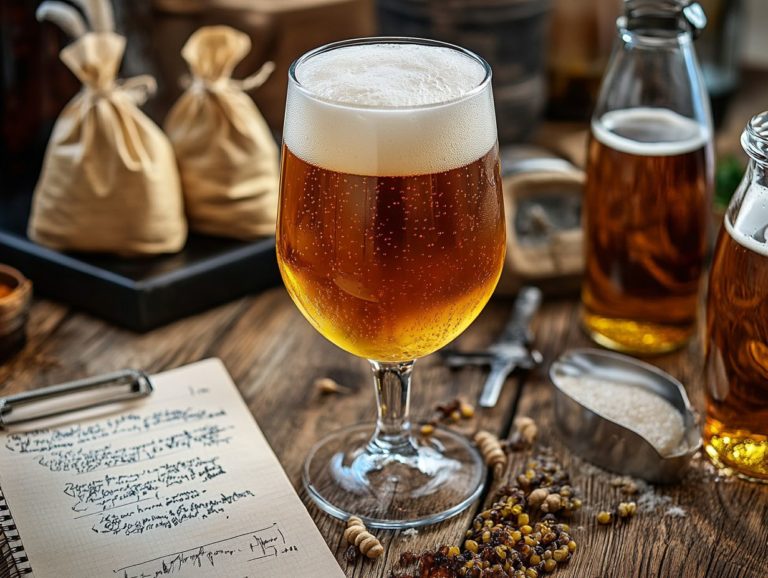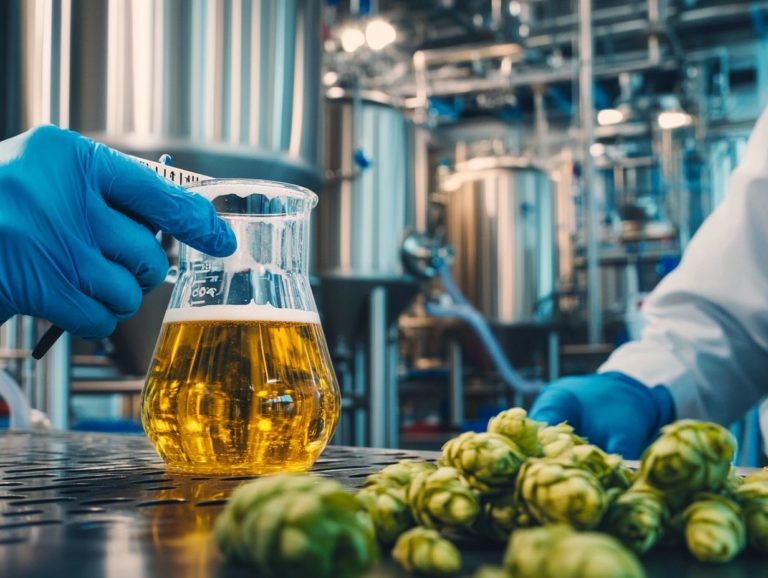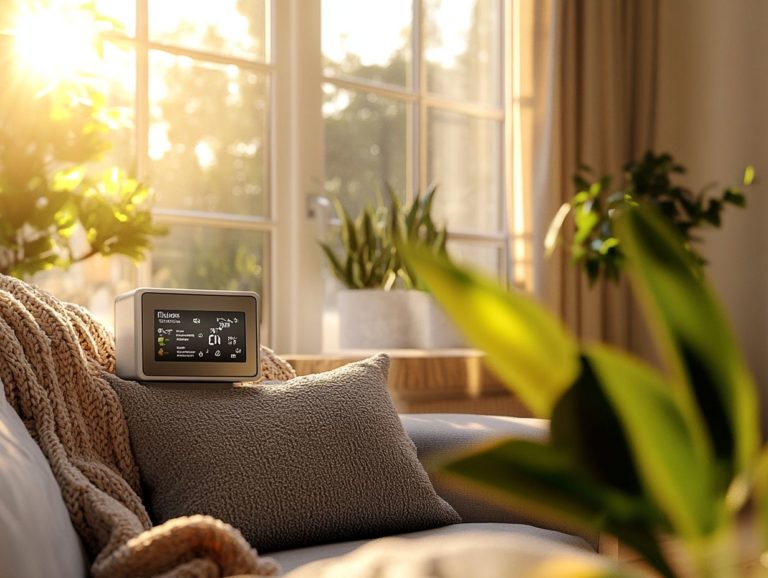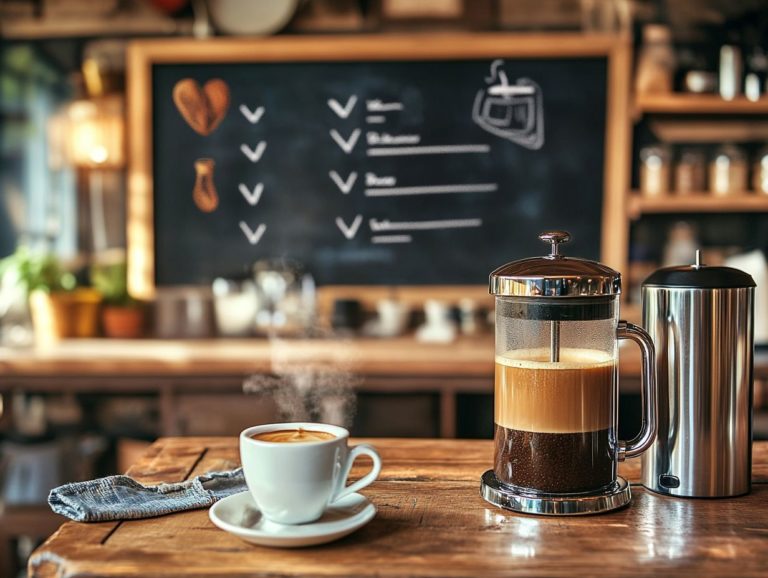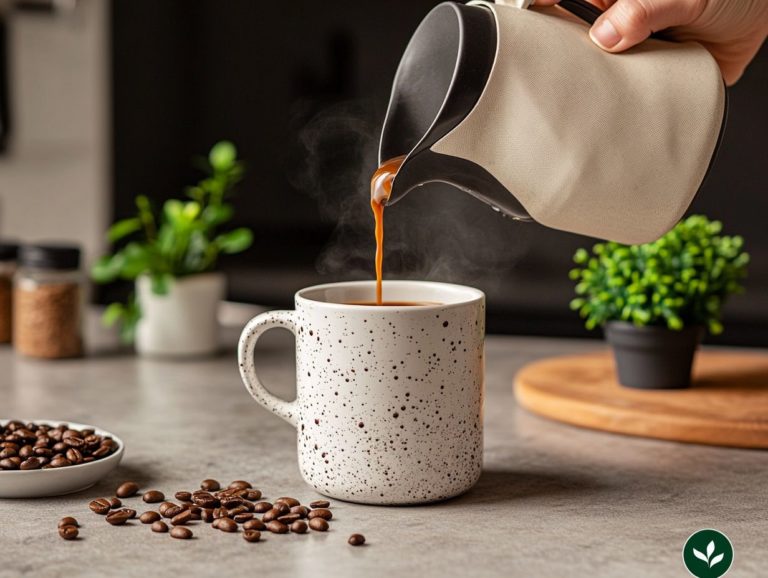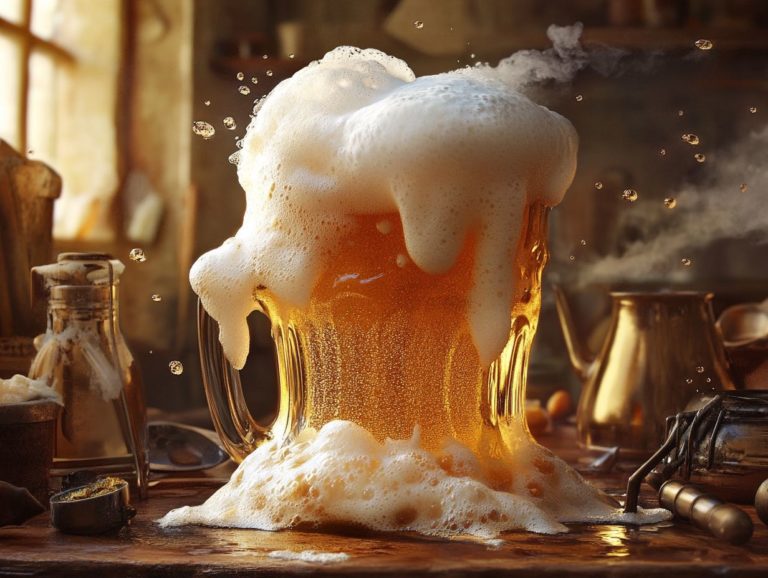Fixing Beer Aroma Issues: A Guide
Beer is not merely a refreshing beverage; it is a sophisticated blend of aromas and flavors that enrich your drinking experience. Imagine crafting a beer that not only quenches your thirst but also tantalizes your senses! Whether you are sampling different beer styles or crafting your own homebrew, understanding the nuances of aroma is essential.
When those enticing aromas take a turn for the worse, they can seriously diminish your enjoyment of the brew. It s crucial for you, whether a brewer or an enthusiast, to grasp the underlying causes of aroma issues ranging from the brewing process to the quality of ingredients, storage methods, and packaging practices, including the use of proper brewing equipment.
This guide delves into common aroma problems, offers solutions for rectifying them, and shares tips for preventing future issues. Act now to ensure your beer’s aroma is perfect every time!
Contents
- Brewing Quality Beer: Aromatic Best Practices
- When Should You Seek Professional Help?
- How Can You Prevent Beer Aroma Issues in the Future?
- Frequently Asked Questions
- What are common beer aroma issues that can occur during brewing?
- How can I fix a lack of aroma in my beer?
- Common Aroma Problems in Beer and How to Solve Them
- How to Ensure Consistent and Strong Aromas in Your Beer
- Can I Fix Beer Aroma Issues After Brewing?
- Where to Find More Information on Fixing Beer Aroma Issues
Key Takeaways:
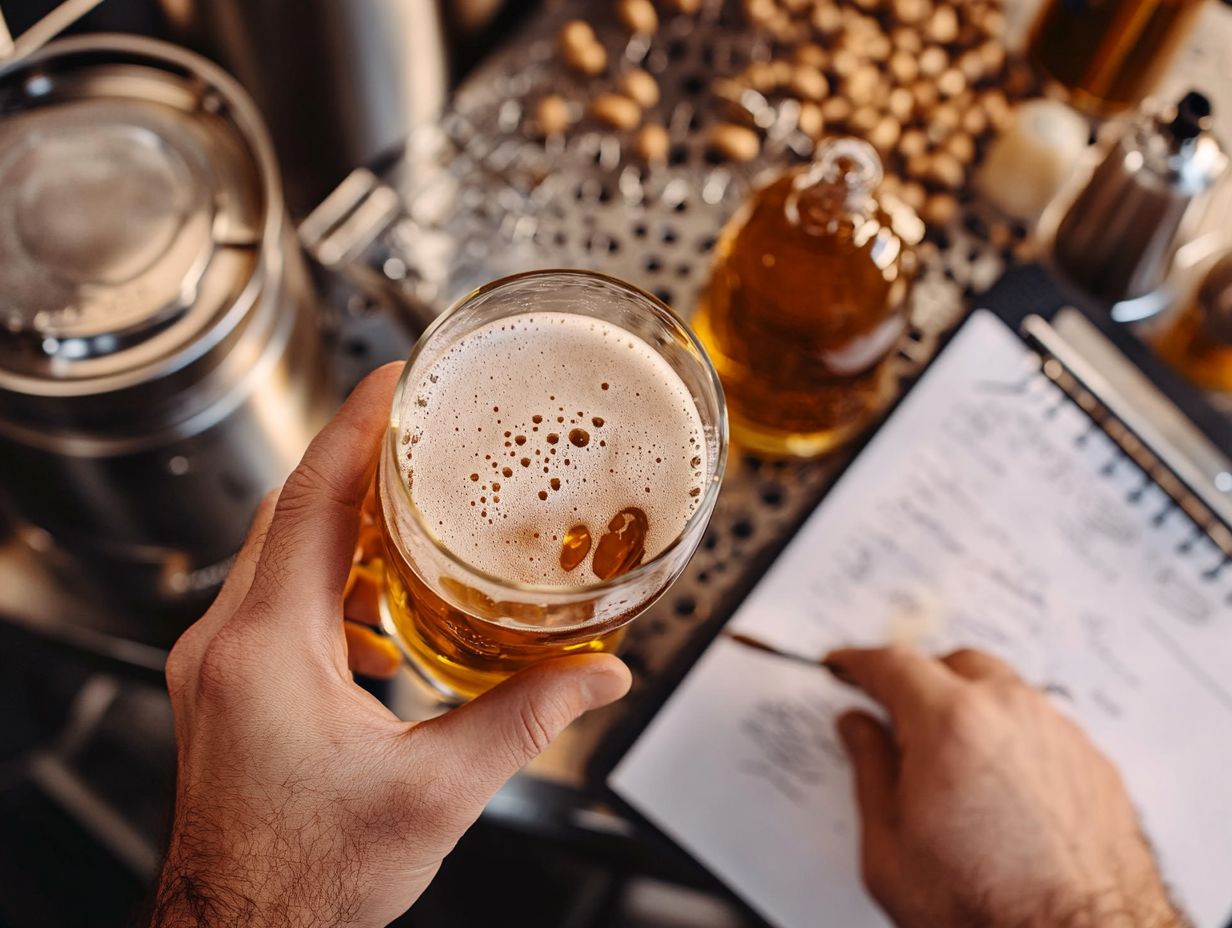
- Proper cleaning and sanitization of equipment can prevent many beer aroma issues.
- Adjusting the brewing process, including monitoring temperature control and using clarifying agents, can also help fix and prevent aroma issues.
- Proper storage and packaging are crucial in maintaining the aroma of beer.
What Causes Beer Aroma Issues?
Understanding the causes of beer aroma issues is essential for you as a homebrewer aspiring to craft high-quality beer. The aromas present in your brew can greatly impact the overall drinking experience. A variety of factors can lead to those undesirable scents, including the presence of esters, which give fruity aromas, phenols, which can create medicinal or smoky flavors, and other flavor compounds.
From the brewing process to fermentation techniques, each step must be executed with precision to prevent off-flavors like diacetyl and DMS, which can arise during fermentation. Your choice of ingredients and the cleanliness of your brewing equipment are critical for ensuring that your final product remains free from infection and oxidation. This ultimately enhances the character and clarity of your beer. Using clarifiers and monitoring each brewing batch carefully can help correct any issues early.
1. Brewing Process
The brewing process is a pivotal factor in shaping your beer s final aroma and overall quality. It encompasses various stages from mashing to fermentation. Each stage demands your careful attention and precise execution to minimize the risk of introducing off-flavors like diacetyl and DMS. It is crucial to use proper brewing techniques and maintain your brewing equipment to avoid these issues.
During mashing, when you mix crushed grains with hot water, enzymes activate to convert starches into fermentable sugars, resulting in the wort. The next step, boiling the wort, is essential; it sterilizes the liquid and extracts flavors from added hops, which contribute to the aroma and bitterness of your beer.
Once the wort cools, it s time for fermentation. This is when yeast is introduced, transforming sugars into alcohol and carbon dioxide. Maintaining the right conditions during this stage is crucial temperature fluctuations and inadequate sanitization can result in unwanted esters or phenols, leading to off-flavors.
Conditioning is where your beer matures. Sanitation remains paramount throughout the process to prevent any unwanted microbes from contaminating your brew. By utilizing specific equipment, such as fermenters equipped with temperature control and clarifying agents like Polyclar, you significantly enhance the aromatic profile. This ensures a fresher and more enjoyable final product.
With these insights, you are now equipped to brew like a pro. Cheers to your flavorful adventures in brewing!
2. Ingredients
The selection of ingredients in brewing is crucial in shaping the aroma and flavor profile of the final beer. Each component yeast strains, hops, and malts contributes distinct aromas that can lead to a range of desirable and sometimes undesirable scent characteristics.
For example, hops infuse delightful floral and citrusy notes. Certain yeast strains introduce unique fruity esters or spicy phenols to the blend. When you choose malts, you re not just adding body and color; you re also incorporating various aroma compounds such as caramel or roasted characteristics.
Be mindful of specific elements like DMS (dimethyl sulfide), which can impart a cooked corn aroma; diacetyl, which might introduce unwanted buttery notes; and acetaldehyde, a compound that can give a green apple aroma. The art lies in the careful balancing of these ingredients, allowing for a vast spectrum of beer styles. This ranges from richly aromatic IPAs with vibrant hop varieties to smoother lagers that emphasize malt-forward profiles with minimal hop presence.
Every choice you make plays a significant role in the final experience, highlighting the artistry involved in crafting exceptional brews.
3. Storage and Packaging
Proper storage and packaging techniques are crucial for preserving the integrity of beer’s aromas and flavors. This greatly enhances your drinking experience. Inadequate storage can lead to undesirable off-flavors and aromas, with oxidation often introducing a papery or musty scent that can spoil the enjoyment.
To create optimal conditions for your beer, pay close attention to factors like light exposure, temperature stability, and humidity levels. Storing beer in a dark, cool place, away from direct sunlight, helps prevent the formation of skunky flavors that can ruin even the finest brews. Aim to maintain a temperature range of 45-55 F, allowing your beer to age gracefully and maintain its clarity.
Humidity control is equally vital; excessively low humidity can dry out caps, increasing the risk of oxidation and compromising quality. Packaging techniques also play a significant role. Bottles made of dark glass can shield against harmful light, while cans provide a complete seal that protects against oxygen and contamination.
By employing the right materials and practices, you can preserve clarity and freshness. This ensures that every sip of your beer remains a delightful experience, free from unwanted oxidation or contamination.
What Are the Common Beer Aroma Issues?
Beer aroma issues are a prevalent concern for homebrewers, as various off-flavors and scents can emerge during the brewing process. You may encounter skunky or lightstruck aromas, which typically result from exposure to light. Similarly, metallic or tinny scents can stem from inadequate sanitation practices or the use of subpar ingredients.
Specific compounds like DMS (dimethyl sulfide), acetaldehyde, and diacetyl can introduce unwelcome characteristics, ultimately diminishing the overall enjoyment of your brew.
1. Skunky or Lightstruck Aroma
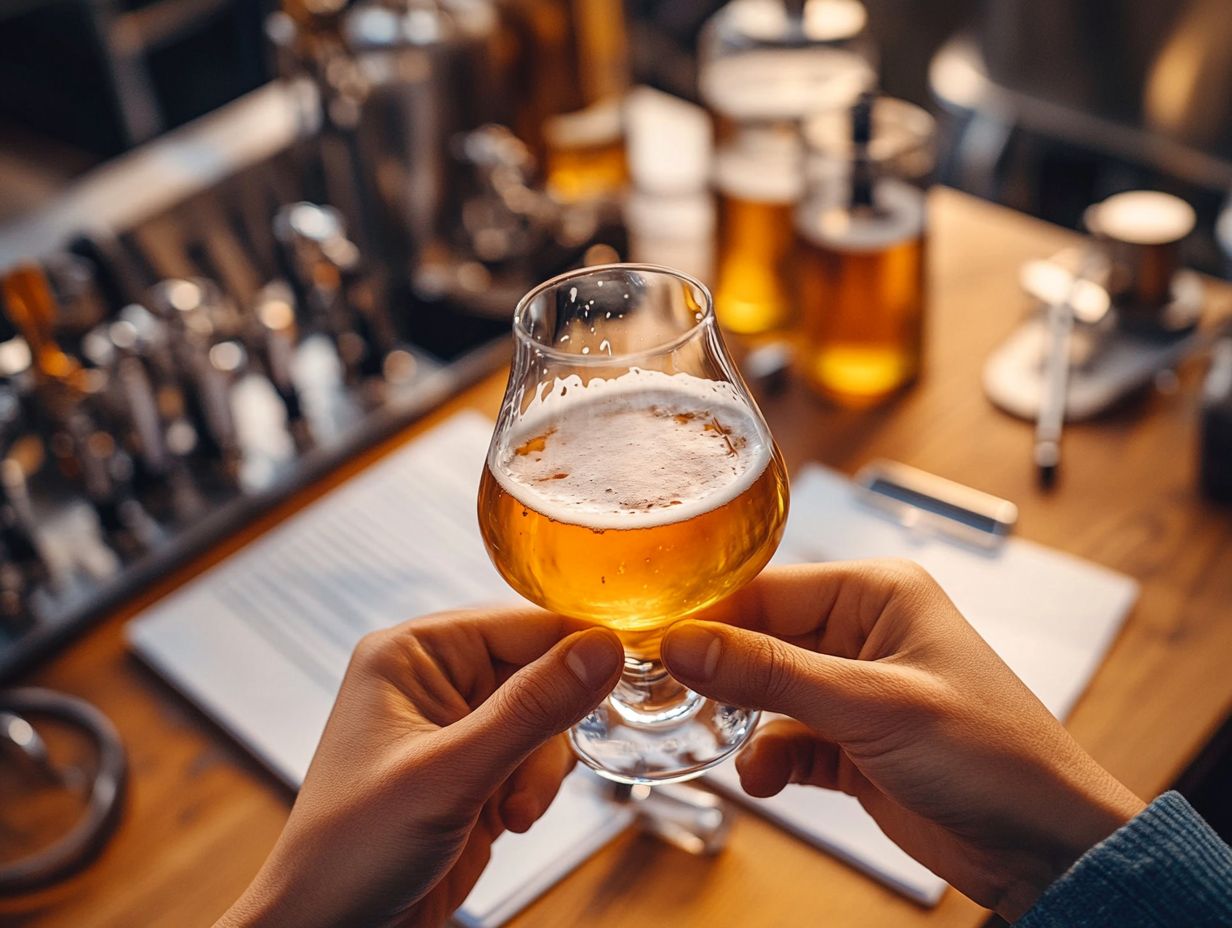
A skunky or lightstruck aroma in your beer often arises from exposure to ultraviolet (UV) light a common challenge for beers packaged in clear or green bottles. This exposure can trigger the formation of 3-methyl-2-butene-1-thiol, which delivers that unmistakable skunky scent, overshadowing the beer s carefully crafted aromas. Avoiding plastic containers can also help minimize this risk.
When this chemical reaction takes place, it can significantly diminish your enjoyment of the beer, distracting you from its meticulously developed flavors. To counteract this issue, brewers and distributors often opt for darker bottles that effectively limit UV light penetration. Proper storage practices are equally important; keeping your beer in cool, dark environments can greatly reduce the risk of unwanted light interaction.
By implementing these preventive measures, you not only safeguard the beer’s integrity but also ensure that you can savor the full range of flavors the brewer intended, free from any unwelcome skunky surprises.
2. Metallic or Tinny Aroma
Metallic or tinny aromas in beer often signal poor sanitation practices or the use of subpar brewing equipment. This off-flavor can emerge when metallic compounds leach into the beer during brewing or packaging, ultimately compromising the overall flavor experience.
To produce a high-quality product, it’s crucial to understand the root causes of these unwanted flavors. Invest in top-notch, non-reactive brewing equipment such as stainless steel fermenters and bottling vessels.
These options help prevent chemical reactions that might lead to those undesirable aromas. Regularly inspecting and maintaining your equipment for wear and tear enhances your brewing environment, significantly reducing the risk of off-flavors creeping in.
Rigorous cleaning and sanitization methods are important for protection. Using hot water, approved cleaning agents, and thorough rinsing can effectively eliminate any residues.
3. DMS (Dimethyl Sulfide) Aroma
DMS, or dimethyl sulfide, is a volatile compound that can impart a distinct cooked vegetable aroma to beer, often reminiscent of corn or butter. This off-flavor typically emerges during the brewing process when insufficient time is allowed for DMS to evaporate during boiling. Proper boiling techniques and kettle management are essential to prevent this.
To grasp this issue fully, it’s essential to consider the origins of DMS, which primarily forms from the breakdown of sulfur-containing compounds during malt processing. When brewers do not maintain an adequate boil for the appropriate duration or temperature, DMS can end up trapped in the liquid.
Controlling both boiling time and temperature is paramount to prevent this compound from developing. Utilizing techniques such as vigorous boiling and employing cooling methods that swiftly reduce the wort temperature can effectively minimize DMS formation.
By following these best practices, you can protect your beer’s aroma profile and ensure an enjoyable drinking experience.
4. Acetaldehyde Aroma
Acetaldehyde is a compound that can impart an unmistakable green apple aroma to beer, often signaling incomplete fermentation. This off-flavor may occur when the yeast falls short in fully converting sugars, leaving behind this unwelcome compound.
Proper fermentation techniques and the use of a fermentation vessel with good temperature control can help avoid this issue. The formation of acetaldehyde during fermentation can be intensified by several factors, including the specific yeast strain chosen and the fermentation temperature.
When yeast is stressed or unhealthy, it can struggle to complete its metabolic processes, resulting in elevated levels of this compound. Additionally, off-flavors such as phenols and esters might also develop under these conditions.
To address these concerns, prioritize yeast health by utilizing appropriate pitching rates and adding necessary nutrients to ensure that the fermentation environment is optimal for yeast activity.
Managing your fermentation vessel and monitoring fermentation conditions is crucial. Maintaining ideal temperatures and minimizing oxygen exposure can significantly support yeast performance and reduce the risk of off-flavors.
Act now to ensure proper fermentation techniques to avoid this off-flavor ruining your brew! By implementing these strategies and using clarifying agents such as Polyclar, a clarifying agent that helps enhance the clarity and flavor of your final beer, you can achieve a cleaner fermentation profile and enhance the overall aroma of your final beer.
5. Diacetyl Aroma
Diacetyl is a compound that lends a buttery aroma to beer, often emerging when yeast hasn t fully completed its fermentation journey. This off-flavor, sometimes described as butterscotch, is particularly notorious in lagers and can pose a significant challenge for brewers aiming for a pristine profile.
During fermentation, yeast produces diacetyl as a byproduct of amino acid metabolism, especially when it experiences stress from insufficient nutrients or temperature fluctuations. If fermentation occurs too quickly or is otherwise compromised, the yeast may not completely reabsorb the diacetyl it releases, leaving behind unwanted traces in the final product. This issue is often compounded by the presence of other flavor compounds such as esters and phenols.
To mitigate this risk, it s essential to allow sufficient time for fermentation, ensuring that yeast activity is thorough.
Effective yeast management is crucial, including pitching the appropriate amount of healthy yeast and maintaining optimal fermentation temperatures. By attentively considering these elements, you can cultivate a cleaner and more enjoyable beer experience.
6. Papery or Oxidized Aroma
A papery or oxidized aroma can develop in your beer when it has had too much exposure to oxygen, often signaling that it has aged beyond its prime. This off-flavor, often described as tasting like cardboard, becomes particularly pronounced in styles that aren t designed for aging, such as pale ales and IPAs.
When your beer is exposed to oxygen during storage, chemical reactions can wreak havoc on its delicate flavors and aromas, resulting in undesirable characteristics that overshadow the intended profile. Take pale ales and IPAs, for example these vibrant, hoppy brews can lose their bright essence, turning flat and stale. This process, known as oxidation, is certainly not what any brewer envisions for their creation.
To prevent these issues, it s essential to utilize proper packaging techniques, such as using non-oxygen permeable materials and ensuring airtight seals. Storing your beer in cool, dark places can significantly slow down oxidation rates, helping to preserve its freshness, clarity, and flavor integrity for as long as possible.
7. Musty or Moldy Aroma
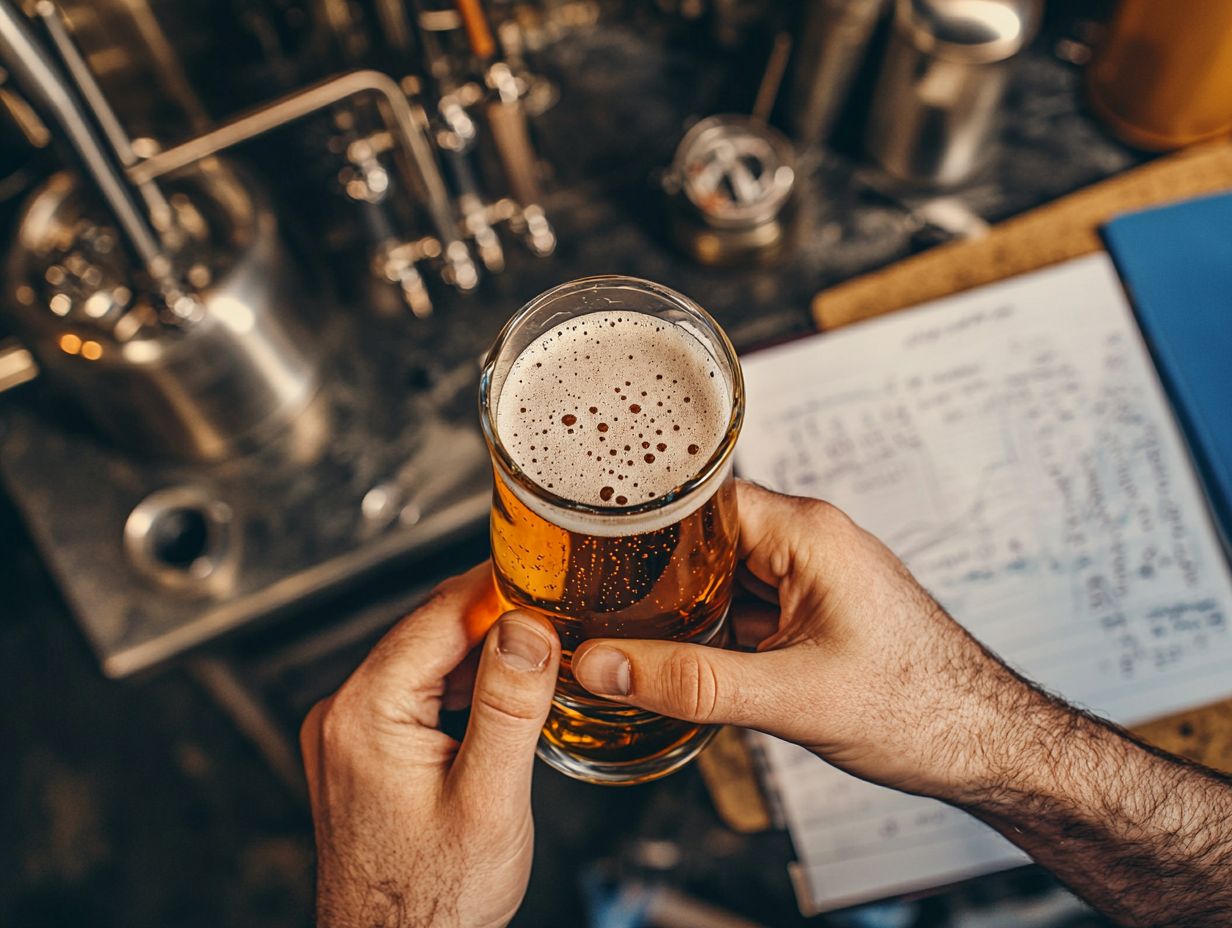
A musty or moldy aroma in your beer often signals a bacterial infection, which can stem from inadequate sanitation during brewing or packaging. This unwelcome scent can easily drown out the beer’s intended flavors and aromas, leaving you less than satisfied. Common culprits include lactic acid bacteria and wild yeast strains like Lactobacillus.
Various strains of bacteria, including certain lactic acid bacteria and wild yeast, can flourish in the brewing environment when proper hygiene isn’t upheld. These pesky microbes not only contribute to off-flavors but also compromise the overall quality of the beer, resulting in the unpalatable mustiness that every brewer fears. This issue is often exacerbated by poor cleaning of brewing equipment and fermentation vessels.
To effectively tackle this concern, it s essential for you to embrace rigorous sanitation practices, such as:
- Thoroughly cleaning all equipment
- Regularly monitoring the brewing environment
- Carefully inspecting ingredients
By maintaining these consistent practices, you can ensure that any potential contamination is caught early, preserving the integrity, clarity, and flavor profiles of the beers you produce.
How Can These Aroma Issues Be Fixed?
Addressing beer aroma issues requires a comprehensive approach that emphasizes prevention, meticulous cleaning, and a deep understanding of the brewing process. This includes the proper use of brewing techniques, such as temperature control and sanitation, to mitigate off-flavors.
By adopting best practices in sanitation, selecting high-quality ingredients, and refining overall brewing techniques, you can significantly minimize the chances of encountering undesirable aromas in your beer. Utilizing clarifiers and properly monitoring the brewing process are also essential steps. This proactive strategy not only enhances the quality of your brews but also elevates your brewing experience to a new level of mastery.
Brewing Quality Beer: Aromatic Best Practices
1. Prevention is Key
Preventing beer aroma issues should be your top priority as a homebrewer. Tackling these concerns before they emerge can save you both time and resources.
Implementing stringent brewing best practices, like thorough cleaning and effective sanitation, as outlined by organizations like BJCP, is essential to maintaining the quality of your final product.
Along with routinely cleaning all your brewing equipment to eliminate any potential contaminants, adhering to strict sanitation protocols during preparation and fermentation will significantly reduce unwanted flavors.
Monitoring fermentation conditions such as temperature and airflow enables you to create the ideal environment for yeast activity. By proactively managing these factors and employing temperature control, you can not only avoid undesirable aromas but also enhance the overall flavor profile of your beer.
Accurately tracking each stage in the brewing process enables you to pinpoint areas that may need adjustment, ultimately leading to a superior and more enjoyable brew. This often involves tweaking elements such as the use of high-alpha hops, which are hops with a higher percentage of alpha acids, or adjusting the types of malt used.
2. Proper Cleaning and Sanitization
Proper cleaning and sanitization of your brewing equipment are essential practices for anyone striving to craft high-quality beer with delightful aromas. When you overlook these crucial steps, you risk contamination that can introduce off-flavors and aromas, potentially ruining an entire brewing batch.
To ensure that every piece of your equipment, from fermentation vessels to transfer tools, is free of microorganisms, it s vital to establish a routine that employs effective methods. For example, many brewers like you use hot water and safe dish soap to remove residue, followed by a thorough rinsing.
Once everything is clean, you can use sanitizing agents like sodium metabisulfite or Star San to eradicate any lingering germs. This routine should also be applied to the brewing kettle and fermentation bucket.
This meticulous process not only helps you maintain a pristine brewing environment but also significantly reduces the risk of infection, ultimately enhancing the overall quality and consistency of the beer you produce. Regularly monitoring for phenols and polyphenols can also contribute to a cleaner final product.
3. Adjusting Brewing Process and Ingredients
Adjusting your brewing process and ingredient choices is essential for resolving and preventing aroma issues in your beer. By carefully monitoring fermentation conditions like controlling the temperature and ensuring yeast health you can significantly decrease the chances of off-flavors cropping up. Utilizing temperature control systems and regularly assessing the clarity and cloudiness of the wort are also beneficial practices.
Selecting the right yeast strain is crucial for achieving aromatic harmony. Different yeast varieties bring unique characteristics to the table, and using a strain that aligns with your desired beer style can enhance aroma profiles rather than detract from them. For instance, a German Hefeweizen yeast can contribute fruity and estery notes while minimizing phenols.
Fine-tuning your ingredient ratios, especially hops and malt, ensures that no single component overwhelms the overall bouquet. Consider using clarifiers and simple techniques to reduce DMS (Dimethyl Sulfide), which can negatively impact flavor, for better flavor balance.
It s wise to regularly taste your beer throughout the fermentation process to spot any emerging issues early on. Keeping a detailed brewing log will also help you track adjustments and their outcomes, ultimately leading to more refined and aromatic brews. This log should include details on yeast health, temperature control, and the clarity of the wort and final product.
You ll be amazed at the difference these practices can make. Start applying these tips today to enhance your brewing process!
4. Proper Storage and Packaging
Proper storage and packaging techniques are essential for preserving the freshness and aromatic integrity of your beer. By adopting best practices in these areas, you can significantly reduce the risks of oxidation and contamination. This ensures that your beer remains enjoyable over time. Utilizing dark bottles or aluminum cans can be particularly effective in protecting the beer from light and air exposure.
Shielding your beer from direct light exposure is paramount. Ultraviolet rays can break down hop compounds, resulting in undesirable flavors you definitely want to avoid. Maintaining a consistent temperature during storage prevents fluctuations that could degrade your beer’s quality.
Using suitable packaging materials like dark bottles, Craftmaster Stainless Steel Growlers, or aluminum cans protects your brew from environmental factors while preserving the intended aroma profile.
By implementing these strategies, you elevate the overall drinking experience. You can fully savor each sip with its original taste and character perfectly intact. Proper storage also prevents the beer from developing plastic or corn-like off-flavors.
When Should You Seek Professional Help?
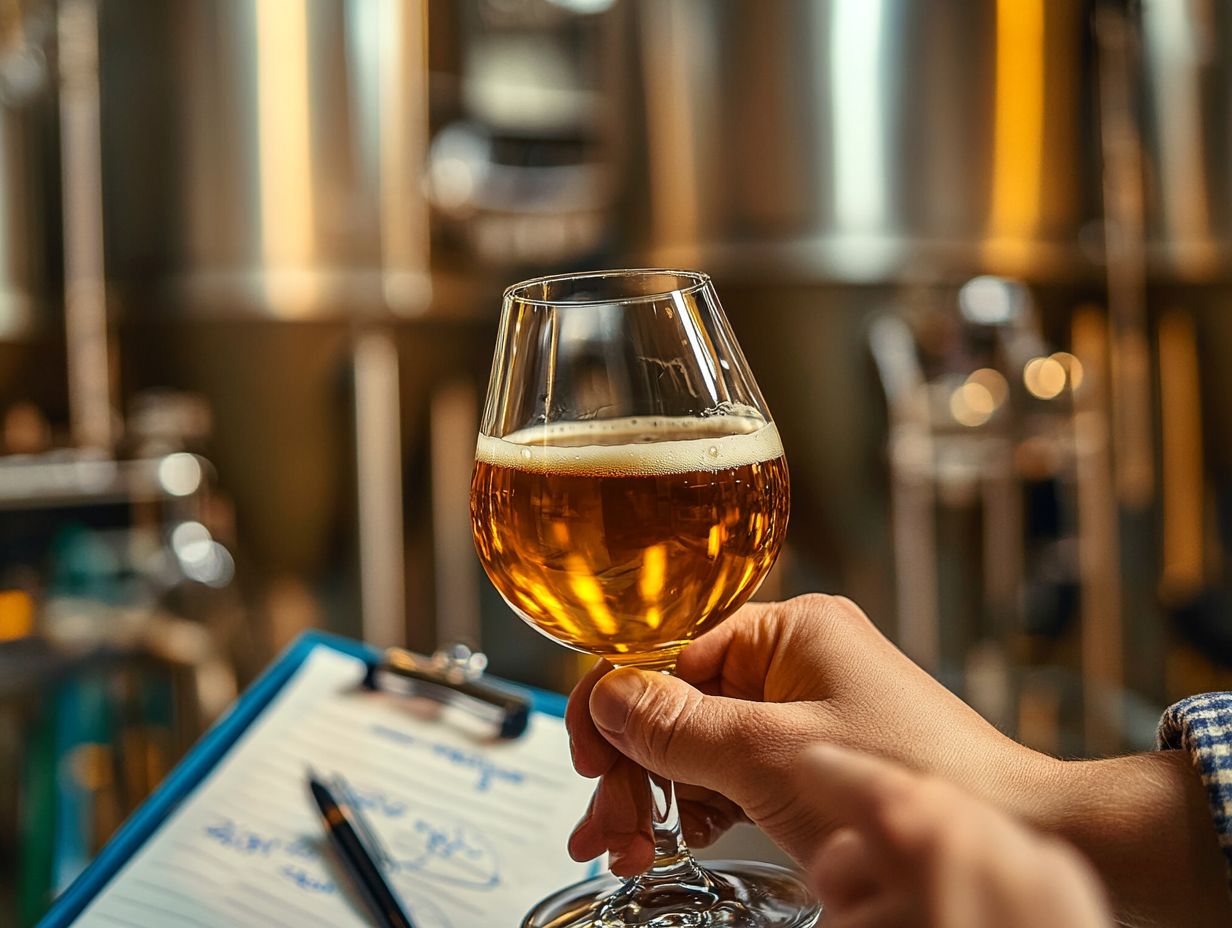
Seeking professional assistance can be a transformative step for you as a homebrewer grappling with persistent brewing issues, especially when aroma problems threaten the quality of your beer. Experienced brewers have valuable insights and solutions that may not be immediately evident to those still honing their craft.
This assistance is particularly useful when addressing complex issues like DMS or polyphenol content. Quality control challenges stemming from inconsistent fermentation or contamination can significantly affect the overall taste and aroma of your brews.
If you re interested in diving into advanced brewing techniques, such as barrel aging or crafting unique flavor profiles, the expertise of seasoned professionals can be invaluable. They can also provide guidance on the use of clarifiers, high-alpha hops, and adjusting brewing process parameters.
By collaborating with industry veterans and using high-quality brewing equipment like Craftmaster Stainless, you gain access to advanced methods. You also learn essential best practices and troubleshooting strategies that refine your skills and elevate your final products.
Ultimately, this professional guidance will dramatically enhance your brewing journey, resulting in exceptional beer that truly reflects your passion and dedication.
How Can You Prevent Beer Aroma Issues in the Future?
Proper sanitation and temperature control are key.
To prevent beer aroma issues in the future, adopt a proactive approach that emphasizes educating yourself on brewing best practices. This includes using clarifiers and clarifying agents while continuously monitoring the brewing process.
By staying informed and vigilant, you can significantly enhance the quality of your beer. This minimizes the risk of encountering any undesirable aromas, such as diacetyl or acetaldehyde.
Check out this video for more insights on brewing techniques and preventing off-flavors in your beer.
Frequently Asked Questions
What are common beer aroma issues that can occur during brewing?
Common beer aroma issues include a lack of aroma, off-putting aromas such as sulfur or diacetyl (which can give a butter or butterscotch smell), and inconsistent or muted aromas.
How can I fix a lack of aroma in my beer?
A lack of aroma can be caused by various factors. These include using old or improperly stored ingredients, too little hops, or not allowing enough oxygen during fermentation.
To fix this, make sure to use fresh ingredients, adjust the amount and timing of hops, and provide enough oxygen to the yeast during fermentation, especially in your fermentation vessel.
Common Aroma Problems in Beer and How to Solve Them
Off-putting aromas can include those reminiscent of plastic or corn.
Off-putting aromas like sulfur or diacetyl can arise from yeast or bacteria contamination. They may also result from improper fermentation temperatures or using contaminated equipment.
To fix these issues, ensure all equipment is properly cleaned and sanitized. Control fermentation temperatures and use high-quality yeast strains. Be aware of potential off-flavors like phenols and polyphenols, which can impart plastic-like or medicinal tastes.
How to Ensure Consistent and Strong Aromas in Your Beer
Maintaining proper fermentation practices and preventing infection is crucial for quality.
For bold and lasting aromas in your beer, choose high-quality ingredients and follow precise brewing practices. Accurately measure and add hops at the correct time, and control fermentation temperatures.
Properly oxygenate the wort and maintain consistency in brewing techniques and sanitation to achieve desired aromas. Consider using hops with a strong flavor profile for stronger hoppy aromas, and ensure proper clarity to avoid cloudiness.
Can I Fix Beer Aroma Issues After Brewing?
Remember to monitor for phenols and other flavor compounds.
While it is best to address and prevent aroma issues during the brewing process, there are steps you can take to fix them afterward. For instance, adding dry hops during secondary fermentation or using a hop tea can enhance aromas.
Blending different batches can also help balance out inconsistent aromas. Using clarifying agents and ensuring proper transfer techniques to avoid oxidation can be beneficial.
Where to Find More Information on Fixing Beer Aroma Issues
There are many online resources and forums dedicated to homebrewing and fixing beer aroma issues. Connect with experienced brewers today to gain insights and tips!
Consider consulting those who follow BJCP guidelines or taking a brewing class to learn more about troubleshooting and improving beer aromas.
Exploring specific beer styles like German Hefeweizen or learning about compounds like Lactobacillus, a type of bacteria used in sour beer production that can enhance certain flavors, can also be very beneficial.

